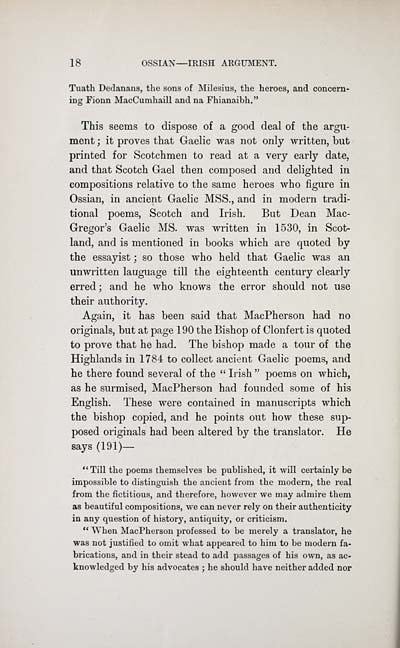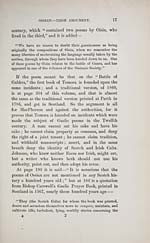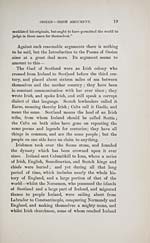Download files
Complete book:
Individual page:
Thumbnail gallery: Grid view | List view

18 OSSIAN — IRISH ARGUMENT.
Tuath Dedanans, the sons of Milesius, the heroes, and concern-
ing Fionn MacCumhaill and na Fhianaibh."
This seems to dispose of a good deal of the argu-
ment ; it proves that Gaelic was not only written, but
printed for Scotchmen to read at a very early date,
and that Scotch Gael then composed and delighted in
compositions relative to the same heroes who figure in
Ossian, in ancient Gaelic MSS., and in modern tradi-
tional poems, Scotch and Irish. But Dean Mac-
Gregor's Gaelic MS. was written in 1530, in Scot-
land, and is mentioned in books which are quoted by
the essayist ; so those who held that Gaelic was an
unwritten lauguage till the eighteenth century clearly
erred; and he who knows the error should not use
their authority.
Again, it has been said that MacPherson had no
originals, but at page 190 the Bishop of Clonfert is quoted
to prove that he had. The bishop made a tour of the
Highlands in 1784 to collect ancient Gaelic poems, and
he there found several of the " Irish " poems on which,
as he surmised, MacPherson had founded some of his
English. These were contained in manuscripts which
the bishop copied, and he points out how these sup-
posed originals had been altered by the translator. He
says (191) —
" Till the poems themselves be published, it will certainly be
impossible to distinguish the ancient from the modern, the real
from the fictitious, and therefore, however we may admire them
as beautiful compositions, we can never rely on their authenticity
in any question of history, antiquity, or criticism.
" When MacPherson professed to be merely a translator, he
was not justified to omit what appeared to him to be modern fa-
brications, and in their stead to add passages of his own, as ac-
knowledged by his advocates ; he should have neither added nor
Tuath Dedanans, the sons of Milesius, the heroes, and concern-
ing Fionn MacCumhaill and na Fhianaibh."
This seems to dispose of a good deal of the argu-
ment ; it proves that Gaelic was not only written, but
printed for Scotchmen to read at a very early date,
and that Scotch Gael then composed and delighted in
compositions relative to the same heroes who figure in
Ossian, in ancient Gaelic MSS., and in modern tradi-
tional poems, Scotch and Irish. But Dean Mac-
Gregor's Gaelic MS. was written in 1530, in Scot-
land, and is mentioned in books which are quoted by
the essayist ; so those who held that Gaelic was an
unwritten lauguage till the eighteenth century clearly
erred; and he who knows the error should not use
their authority.
Again, it has been said that MacPherson had no
originals, but at page 190 the Bishop of Clonfert is quoted
to prove that he had. The bishop made a tour of the
Highlands in 1784 to collect ancient Gaelic poems, and
he there found several of the " Irish " poems on which,
as he surmised, MacPherson had founded some of his
English. These were contained in manuscripts which
the bishop copied, and he points out how these sup-
posed originals had been altered by the translator. He
says (191) —
" Till the poems themselves be published, it will certainly be
impossible to distinguish the ancient from the modern, the real
from the fictitious, and therefore, however we may admire them
as beautiful compositions, we can never rely on their authenticity
in any question of history, antiquity, or criticism.
" When MacPherson professed to be merely a translator, he
was not justified to omit what appeared to him to be modern fa-
brications, and in their stead to add passages of his own, as ac-
knowledged by his advocates ; he should have neither added nor
Set display mode to: Large image | Transcription
Images and transcriptions on this page, including medium image downloads, may be used under the Creative Commons Attribution 4.0 International Licence unless otherwise stated. ![]()
| Early Gaelic Book Collections > Matheson Collection > Popular tales of the west Highlands > Volume 4 > (34) |
|---|
| Permanent URL | https://digital.nls.uk/81487465 |
|---|
| Description | Volume IV. |
|---|---|
| Shelfmark | Mat.77 |
| Additional NLS resources: | |
| Attribution and copyright: |
|
| Description | Items from a collection of 170 volumes relating to Gaelic matters. Mainly philological works in the Celtic and some non-Celtic languages. Some books extensively annotated by Angus Matheson, the first Professor of Celtic at Glasgow University. |
|---|
| Description | Selected items from five 'Special and Named Printed Collections'. Includes books in Gaelic and other Celtic languages, works about the Gaels, their languages, literature, culture and history. |
|---|

